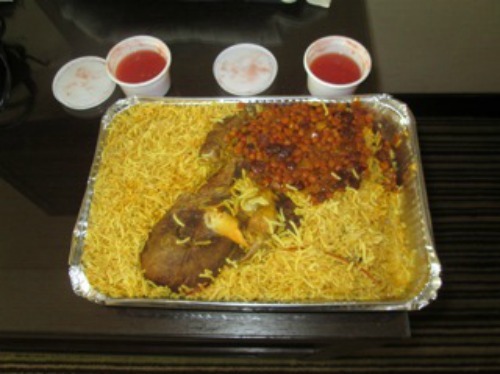The 3 M's Of Qatari Cuisine
Amid the affluence of Qatar's explosive growth, the streets of Doha are lined with fast-food chains and high-end restaurants that rival those in New York or London. The thumb-shaped peninsula that's about the size of Connecticut has transformed itself from a dusty backwater port to the richest country in the world in 40 years, according to Forbes magazine. The Qataris have invited the world to be a part of that development, resulting in them being a minority in their own country with about 75 percent of the population hailing from somewhere else, according to The Economist.
Despite the dwindling number of Qataris, Qatari cuisine thrives in Doha, and the food reflects the immediate influences at the crossroads of Arabian Gulf Coast, Levantine cooking, and the pan-Arab world. The large influx of guest workers from places like Iran, the Philippines, and Pakistan has brought varying spices and flavors to Qatar's streets. Qatari foods have evolved to complement the shifting population and its arid landscape and peninsular location with fresh fish and heat-beating stews.
Throughout the day, Qatari women can be seen serving authentic Qatari cuisine from steaming pots of all shapes and sizes at the Souq Waqif, a rambling market in Doha. At least one stall in on the main strolling pathway of the souq is open into the night. Look for the sign that reads "Mohamed's Mom" to sample the three M's of Qatari cuisine: machbous, mathrooba, and margooga
Machbous
The hallmark of Qatari cuisine is machbous, a richly spiced mélange of Eastern spices, basmati rice, pine nuts, and raisins topped with a chunk of mutton, chicken, or locally caught hammour fish (a variant of grouper) typically served family-style in a communal platter. If you can't find a Qatari home to try it in, it is available in unmarked back-alley kitchens and foods stalls in the Souq Waqif. Machbous is similar to kabsa, a Saudi Arabian rice dish that looks like biryani and is topped with fried onions. Each family has its own recipe, but local machbous may feature cardamom, cloves and allspice, rose water-steeped rice, and tomato paste. The marinated meat is traditionally cooked in an underground oven, with heated flat stones or in more modern kitchens, a pressure cooker.
Machbous is sometimes served with mutton and a tomato-based spicy salsa on the side. Photo credit: David Ressel
Mathrooba
Mathrooba is another local delicacy readily available in the Souq Waqif or as a special iftar treat to break the Ramadan fast. Mathrooba is similar to another local dish, h'riss, a dish of chicken with creamy, buttery wheat porridge. In contrast, mathrooba is more like a soupy polenta, with the meat simmered and stewed with mashed beans fusing the flavors into a pasty-mix that locals claim helps to stave off the hot temperatures.
The Souq Waqif has many stalls selling steaming pots of mathrooba. Photo credit: David Ressel
Margooga
Another popular stew-like dish is margooga. Margooga has many of the same Eastern spices found in other Qatari dishes but includes heartier vegetables like eggplant and carrots. A chunky piece of farrago, a sponge-like bread similar to Ethiopian injera, is served with it to soak up the flavors.
H'riss is a popular porridge-type dish in Doha. Photo credit: David Ressel
Even with this globalization, these three M's of Qatari cuisine: machbous, mathrooba, and margooga, have helped preserve a vibrant local culture in Doha — if you can find it.

